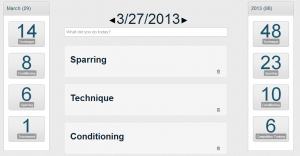In high school, I was playing basketball over at a friend’s house. It was a 3-on-3 game in his driveway. We’d been playing for a little while and someone asked “What’s the score?” Another friend replied, “Ask Nate, he’s kind of like a human calculator.” I did know the score, as I had been keeping track in my mind the entire time (but it doesn’t exactly take a calculator to keep track of a 3-on-3 game to 10 by 1’s game.) That’s something I’ve always done. If I’m watching a game I can almost always tell you what the score is, about how much time is left and in cases of football, what the down and distance is. Obviously this is easier now because all that information is plastered all over the screen. But even before it was, it was just something that I mentally kept track of. It wasn’t even really all that conscious. I never made it a point to say “Ok, remember, it’s 7-3 with 8 minutes left in the 2nd.” It just kind of happened.
When I first started BJJ I was still very much that way. Driving home after my first sparring class, I replayed almost all of the matches. I remembered when the first guy passed my guard like it was nothing. I remember the second guy getting mount etc. And that happened for quite a while. In fact, I even detailed my first submission in somewhat in-depth detail.
However, over the past month or so, I’ve noticed something has changed when I spar. I’m aware of how I’m doing in the midst of each session. For example, I might be fighting off a back attack for 3:30 of a 4 minute round, and I realize that I’m in a bad place. But at the end of the night, I don’t instantly remember who got me with what, which matches went the whole time without a submission, and which ones I got submissions in. I will remember if it’s someone who always taps me out and I was able to survive. Or if I got a new submission that I wanted to work on. But other than that, the matches just blend together for me.
I think there are a couple of reasons for this. First, it’s a process of maturation. Although I’m still very new to BJJ (10 months this week) I’m starting to move away from some of the early tendencies of “all that matters is getting a submission.” As I progress in the sport, I see that there are a lot of things to learn, and lots of areas to grow. And that, especially in practice, the submission isn’t all important.
Secondly, I think competing helped me in this area as well. After my tournament back in March, I realized that there are some areas of my game that need more immediate attention than others. For example, when someone gets my guard open, I need to be mobile and not just let them right into side control. What this did to me in sparring was take the emphasis off of retaining guard, and focus on my movement when they passed my guard. In doing that, I became focused on hip movement, and escapes. I started judging the quality of my sparring sessions by whether or not I executed the correct escape. It changed the definition of success for me. The following sparring session once would have definitely been a failure in my mind, but now might be a success:
- Start on our knees
- Get guard
- Grip fight
- Attempt a submission
- Partner starts to pass
- Shrimp away, up to my elbow
- Get back to my knees
- Get taken down
- Get mounted
- Get submitted
The final result may or may not have changed, but the middle section from “Grip Fight” to “Get back to my knees” was what was important to me.
Finally, I realized that sparring class in the gym is just that. It’s a class…at the gym. Most people there are trying to work on different parts of their game. You often start in non-neutral positions. Is it super impressive that I got an Ezequiel choke from mount, if I got to start in mount?
Even though I don’t track each match like I used to, and at the end of the night I couldn’t tell you what my “record” was, I’m still tracking my progress. It’s just that I’ve started using a different metric.




